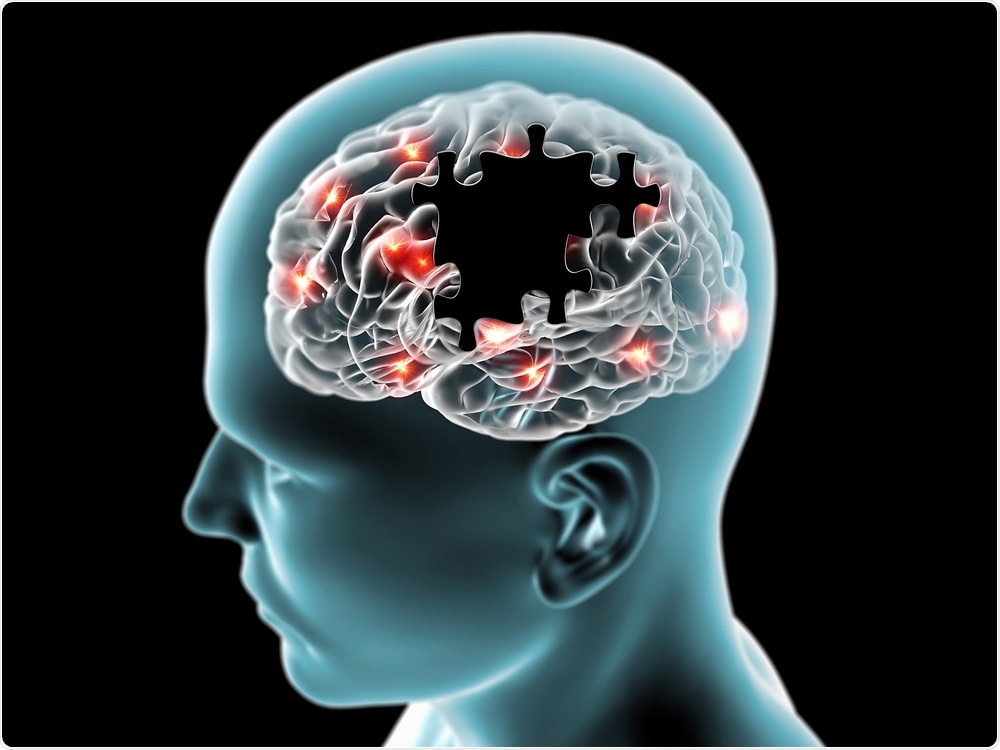According to a new mathematical model published recently in eLife, Alzheimer’s disease has some important similarities with healthy aging.

Alzheimer's Disease. Image Credit: Naeblys/Shutterstock.com
The model gives novel insights into the multiscale biological alterations in the old and neurodegenerative brain, which has crucial implications for finding future Alzheimer’s disease therapy targets.
Researchers created a mathematical model with a variety of biological data, ranging from “microscopic” information derived from gene activity to “macroscopic” information derived from molecular MRI and PET scans concerning the brain’s load of toxic proteins (amyloid and tau), cerebrovascular flow, metabolism, neuronal function, and tissue structure.
In both aging and disease research, most studies incorporate brain measurements at either micro or macroscopic scale, failing to detect the direct causal relationships between several biological factors at multiple spatial resolutions. We wanted to combine whole-brain gene activity measurements with clinical scan data in a comprehensive and personalized model, which we then validated in healthy aging and Alzheimer’s disease.”
Quadri Adewale, Study First Author and PhD Candidate, Department of Neurology and Neurosurgery, McGill University, Canada
As part of the Alzheimer’s Disease Neuroimaging Initiative cohort, 460 patients had at least four distinct types of brain scans at four separate time periods for the study.
Among the 460 subjects, 151 were clinically diagnosed as healthy control (HC) or asymptomatic, 161 as having an early mild cognitive impairment (EMCI), 113 as having a late mild cognitive impairment (LMCI), and 35 as having probable Alzheimer’s disease.
The results of these multimodal scans were coupled with gene activity data from the Allen Human Brain Atlas, which gives information on whole-brain gene expression for 20,267 genes. The brain was then divided into 138 different gray matter areas to combine the gene data with the functional and structural data from the scans.
The researchers next investigated causal correlations between the spatial genetic patterns and information from their scans, which they cross-referenced with age-related changes in cognitive performance.
They discovered that the model's ability to predict the level of cognitive function decline was greatest for Alzheimer’s disease, followed by less severe declines in cognition (LCMI and ECMI), and lastly healthy controls.
This demonstrates that the model can recreate the individual multifactorial changes in hazardous protein accumulation, tissue structure, and neuronal function found in clinical scans over time.
Using a subgroup of healthy control subjects who stayed clinically stable for nearly eight years, the researchers next utilized the model to seek for genes that cause cognitive deterioration overtime throughout the typical course of healthy aging. Memory and executive functions, like flexible thinking, were affected by cognitive alterations.
They discovered eight genes that contributed to the imaging dynamics revealed in the scans and coincided with cognitive changes in healthy people. It is worth noting that the genes that changed in healthy aging are also known to impact amyloid-beta and tau—two essential proteins in the development of Alzheimer’s disease.
They then performed a similar study to hunt for genes that contribute to the progression of Alzheimer’s disease. They discovered 111 genes that were connected to scan data and related cognitive alterations in Alzheimer’s disease.
Finally, they investigated the roles of the 111 genes discovered and revealed that they related to 65 distinct biological processes, the majority of which were associated with cognitive decline and neurodegeneration.
Our study provides unprecedented insight into the multiscale interactions among aging and Alzheimer’s disease-associated biological factors and the possible mechanistic roles of the identified genes.”
Yasser Iturria-Medina, Study Senior Author and Assistant Professor, Department of Neurology and Neurosurgery, McGill University
“We’ve shown that Alzheimer’s disease and healthy aging share complex biological mechanisms, even though Alzheimer’s disease is a separate entity with considerably more altered molecular and macroscopic pathways. This personalized model offers novel insights into the multiscale alterations in the elderly brain, with important implications for identifying targets for future treatments for Alzheimer’s disease progression,” concluded Iturria-Medina.
Source:
Journal reference:
Adewale, Q., et al. (2021) Integrated transcriptomic and neuroimaging brain model decodes biological mechanisms in aging and Alzheimer’s disease. eLife. doi.org/10.7554/eLife.62589.